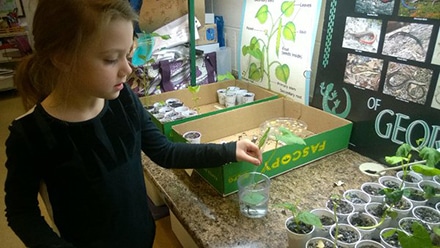The “Conservation Teacher of the Year” grant is coordinated by the Wildlife Conservation Section of DNR’s Wildlife Resources Division. Funding is possible thanks to support from the Section’s friends group, The Environmental Resources Network (TERN).
Through education, research and management, Wildlife Conservation works to safeguard Georgia’s native diversity of wild animals, plants and their habitats, while also striving to increase public enjoyment of the outdoors. The purpose of the grant is to recognize and help an outstanding teacher who uses Georgia’s native wildlife, plants, and habitats as the context for learning, according to Linda May, DNR environmental outreach coordinator.
“Georgia is home to an amazing diversity of wildlife. We want to support a talented teacher who highlights these natural wonders with his or her students in creative ways.” May said.
Previous grant recipients taught students through cross-curricular outdoor experiences. For example, students at Samuel E. Hubbard Elementary in Forsyth constructed a bog garden out of a regularly flooded area on campus. In addition to creating wildlife habitat, the bog garden solved a water runoff problem and now serves as an outdoor classroom. Third-grade teacher Tiffany Smith coordinated this effort, using grant funds to buy all the supplies needed for students to construct the bog garden and fill it with native plants. Funds were leveraged by equipment donations as well as labor by parents and community volunteers.

This fall, another talented teacher will be selected to receive funding based on project design, which will be evaluated through grant proposal questions. Projects that are especially creative and teach about Georgia’s rare or endangered species, as well as solid projects that have no other means of funding, will earn bonus points. See www.georgiawildlife.com/TeachingConservationGrant for details.
The deadline to apply is September 17, 2018. DNR will notify the grant winner by October 5, 2018.
For more information about the grant, please contact Linda May (linda.may@dnr.ga.gov, 706-557-3226) or Anna Yellin (anna.yellin@dnr.ga.gov, 706-557-3283).
CONSERVATION TEACHER GRANT/AT A GLANCE
• $1,000 grant to a Georgia third-, fourth- or fifth-grade public or private school teacher (including science specialists) who demonstrates exceptional energy and innovation in teaching life sciences.
• Provided by the Georgia DNR Wildlife Conservation Section and friends group The Environmental Resource Network, or TERN.
• Deadline to apply is Sept. 17. Recipient announced by Oct. 5.
• For more: www.georgiawildlife.com/TeachingConservationGrant or contact Linda May (linda.may@dnr.ga.gov, 706-557-3226) or Anna Yellin (anna.yellin@dnr.ga.gov, 706-557-3283).


